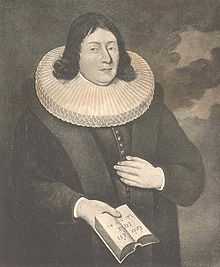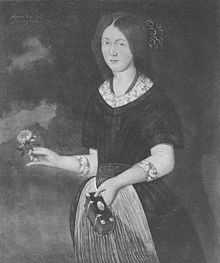Hans Paus


Hans Paus (born 1656 in Hjartdal, died 1715) was a Norwegian priest and poet. He was parish priest in Kviteseid from 1683 until his death. A popular man in his parish who learned the local dialect (at a time when most church officials and civil servants used Danish), he is noted for being the first to write in dialect in Norway. His poem Stolt Anne (ca. 1700), written in the Kviteseid dialect, became a popular folk song in Telemark. 12 verses were included in Norske Folkeviser (1853) by Magnus Brostrup Landstad and Henrik Ibsen, a relative of Hans Paus, paraphrased the poem in the drama Lady Inger of Ostrat.[1] The poem honored Anne Clausdatter, the owner of Borgestad Manor and a relative of Paus. She rewarded him with an agricultural property (Bukkøy) for it. He owned several agricultural properties in Kviteseid.
Hans Paus was the son of Povel Pedersson Paus (1620–1715), parish priest in Hjartdal, and Ingrid Corneliusdatter Trinnepol, who belonged to the Skien patriciate who had made a fortune in the sawmill industry (her family might originate in Trinitapoli, Italy). Hans Paus married Susanne Amundsdatter Morland, daughter of the provost of Øvre Telemark Amund Hanssøn Morland.[2] He succeeded his father-in-law as parish priest in Kviteseid. Amund Morland, of Danish origin, had succeeded Hans Paus' grandfather Peder Paus (born 1590) as the Kviteseid parish priest and provost; hence, the Paus and Morland families have been referred to as a dynasty of priests in Øvre Telemark.[3] Hans Paus' maternal grandparents were timber merchant, sawmill owner and councilman in Skien, Cornelius Jansen Trinnepol (1611–1678) and Anne Iversdatter (1605–1642), a daughter of councilman Iver Christensen and Margrethe von Ansbach.[4] Susanne's maternal grandparents Christen Andersen and Anne Gundersdatter owned Borgestad Manor.[3]
Original painted portraits from 1685 of Hans and Susanne came in the possession of Christopher Tostrup Paus and are today found at Herresta in Sweden.[5]
Hans Paus was the brother of the judge of Øvre Telemark, Cornelius Paus (1662–1723), who used a coat of arms featuring a wild man.[6]
References
- ↑ Francis Bull, Gerhard von der Lippe Gran, i Edda: nordisk tidsskrift for litteraturforskning, vol. 30. s. 21, 1930
- ↑ S. H. Finne-Grønn (1947). «Nogen oplysninger om presteslekten Morland». Norsk slektshistorisk tidsskrift vol. 11 s. 124-132
- ↑ 3.0 3.1 S. H. Finne-Grønn (1943). Slekten Paus : dens oprindelse og 4 første generasjoner (s. 22). Oslo: Cammermeyer.
- ↑ S. H. Finne-Grønn (1910). «Jørgen v. Ansbach, Engel Jensen og slegten Klouman». Norsk Personalhistorisk Tidsskrift vol. 1 s. 357
- ↑ Henrik Gravenor (1928). Norsk malerkunst: under renessanse og barokk 1550-1700. Oslo: Steen. S. 206–207.
- ↑ Hans Krag (1955). Norsk heraldisk mønstring 1699-1730, Vol. I.
Literature
- D. A. Seip i Norsk Biografisk Leksikon, bd. 10 (1969)
- Landstad, Magnus Brostrup: Norske folkeviser (1853)
- Berge, Rikard: Bygdedikting fraa Telemarki (bd. 11, 1918)